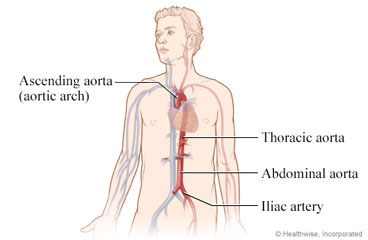Endovascular Aortic Aneurysm Repair: Before Your Procedure

What is endovascular aortic aneurysm repair?
Endovascular aortic aneurysm repair fixes an aneurysm in your aorta. An aneurysm is a weak or bulging part of a vein or artery. Your aorta is a large artery. It carries blood from your heart through your belly to the rest of your body.
If you don't fix this problem, your aorta could burst. This can cause death.
The procedure is called endovascular because a doctor repairs the aneurysm from the inside of the damaged blood vessel (the aorta). It's not a surgery. Local or general anesthesia might be used.
Your doctor may make small cuts in the groin area. Thin tubes, called catheters, are inserted through the cuts and into blood vessels. The doctor guides the catheters into the aorta. A man-made tube is placed in the aneurysm. This tube is called a stent graft.
After the procedure, your blood will flow through the stent graft. It will not push on the aneurysm.
You may spend 1 to 3 days in the hospital. You may be able to return to work and many of your daily activities 1 to 2 weeks after the procedure.
How do you prepare for the procedure?
Procedures can be stressful. This information will help you understand what you can expect. And it will help you safely prepare for your procedure.
 Preparing for the procedure
Preparing for the procedure
- Be sure you have someone to take you home. Anesthesia and pain medicine will make it unsafe for you to drive or get home on your own.
- Understand exactly what procedure is planned, along with the risks, benefits, and other options.
- Tell your doctor ALL the medicines and natural health products you take. Some may increase the risk of problems during your procedure. Your doctor will tell you if you should stop taking any of them before the procedure and how soon to do it.
- If you take a medicine that prevents blood clots, your doctor may tell you to stop taking it before your procedure. Or your doctor may tell you to keep taking it. (These medicines include aspirin and other blood thinners.) Make sure that you understand exactly what your doctor wants you to do.
- Make sure your doctor and the hospital have a copy of your advance care plan. If you don't have one, you may want to prepare one. It lets others know your health care wishes. It's a good thing to have before any type of surgery or procedure.
What happens on the day of the procedure?
- Follow the instructions exactly about when to stop eating and drinking. If you don't, your procedure may be cancelled. If your doctor told you to take your medicines on the day of the procedure, take them with only a sip of water.
- Take a bath or shower before you come in for your procedure. Do not apply lotions, perfumes, deodorants, or nail polish.
- Take off all jewellery and piercings. And take out contact lenses, if you wear them.
 At the hospital or surgery centre
At the hospital or surgery centre
- Bring a picture ID.
- You will be kept comfortable and safe by your anesthesia provider. You may be asleep during the procedure. Or you may get medicine that relaxes you or puts you in a light sleep. The area being worked on will be numb.
- The procedure will take about 1 to 4 hours.
When should you call your doctor?
- You have questions or concerns.
- You don't understand how to prepare for your procedure.
- You become ill before the procedure (such as fever, flu, or a cold).
- You need to reschedule or have changed your mind about having the procedure.
Where can you learn more?
Go to https://www.healthwise.net/patientEd
Enter L357 in the search box to learn more about "Endovascular Aortic Aneurysm Repair: Before Your Procedure".
Current as of: July 31, 2024
